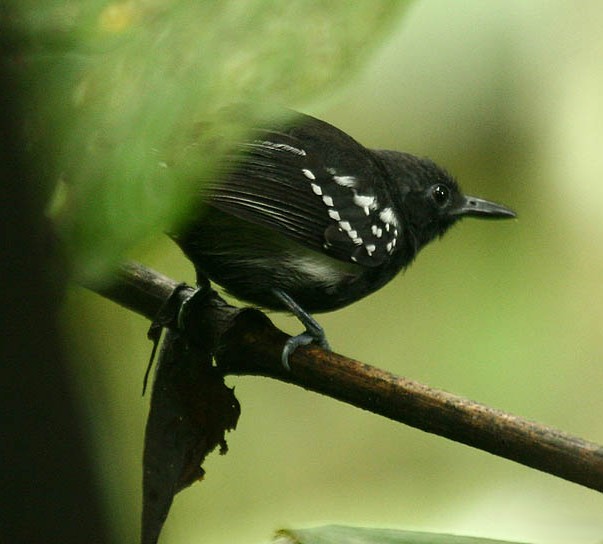White-flanked Antwren
A species of Streaked Antwrens and Allies Scientific name : Myrmotherula axillaris Genus : Streaked Antwrens and Allies
White-flanked Antwren, A species of Streaked Antwrens and Allies
Botanical name: Myrmotherula axillaris
Genus: Streaked Antwrens and Allies
Content
Description General Info
 Photo By Michael Woodruff , used under CC-BY-SA-2.0 /Cropped and compressed from original
Photo By Michael Woodruff , used under CC-BY-SA-2.0 /Cropped and compressed from original Description
The white-flanked antwren is typically 10.7 cm (4.2 in) long, and weighs 8.1 g (0.29 oz). The adult male has dark grey upperparts, black underparts, and black wings with bars of white spots. The flanks and underwings are white. The female and immature male have brown upperparts, yellowish-buff underparts and weakly barred rufous wings. Her flanks and underwings are white, much like the male. Males of the distinctive western race M. a. melaena have black upperparts and underparts, and the female is darker than nominate M. a. axillaris. 
Size
10 cm
Nest Placement
Shrub
Feeding Habits
White-flanked Antwren primarily consumes small insects and other arthropods. It actively forages in foliage, exhibiting agility and specialized feeding techniques. Unique dietary preferences include predation on tiny, elusive prey.
Habitat
White-flanked Antwren inhabits tropical evergreen forests, including terra firme and floodplain varieties, as well as second-growth woodlands. This species also demonstrates adaptability to different elevations, ranging from near sea level in restinga habitats up to 1400 meters. Microhabitat preferences vary across regions, with some populations favoring bamboo stands or river-edge forests.
Dite type
Insectivorous
General Info
Feeding Habits
Bird food type
Behavior
This is a common and confiding bird of primary and second growth forest, usually found in small groups. The female lays two purple-marked white eggs, which are incubated by both sexes for 16 days to hatching, in a small plant fibre and dead leaf cup nest low in a tree or shrub. The white-flanked antwren feeds on small insects and other arthropods taken from twigs and foliage in the lower branches of trees. It has a queep whistle followed by a trilled trrrrrr. M. a. melaena has a two note call, naa-who and a whistled descending pee pee pee-pee-pee-pee-pee-puu-puu call. Given the differences in plumage and vocalisations, the two forms may possibly be different species. 
Distribution Area
The white-flanked antwren is a resident breeder in tropical Central and South America from El Salvador and Honduras south to Amazonian Bolivia and southern Brazil, and on Trinidad. The white-flanked antwren is found throughout the entire Amazon Basin as well as to the southeast in the adjacent Tocantins-Araguaia River drainage, and then in disjunct groups on the southeast coast of Brazil; it also ranges through the Guyanas on the northeast of South America to Pacific and Caribbean coastal regions of Ecuador, Colombia, and Venezuela; also, the entire eastern Venezuela Orinoco River grouping is part of the northern Amazon range. The northern Andes cordillera bifurcates the Central American and coastal groups of the northwest from the Amazonian range. 
Species Status
Not globally threatened.